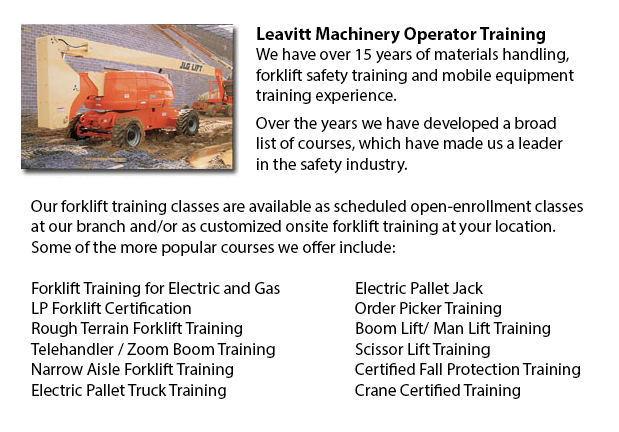
Oakville Aerial Boom Lift Ticket - Aerial forklifts can be utilized to accomplish certain different tasks executed in hard to reach aerial spaces. Some of the duties associated with this style of lift include performing routine preservation on structures with high ceilings, repairing phone and utility cables, raising heavy shelving units, and trimming tree branches. A ladder might also be used for some of the aforementioned projects, although aerial lifts provide more security and stability when properly used.
There are several versions of aerial hoists available on the market depending on what the task needed involves. Painters often use scissor aerial lifts for example, which are classified as mobile scaffolding, effective in painting trim and reaching the 2nd story and above on buildings. The scissor aerial hoists use criss-cross braces to stretch and lengthen upwards. There is a platform attached to the top of the braces that rises simultaneously as the criss-cross braces raise.
Cherry pickers and bucket lift trucks are another variety of the aerial lift. Typically, they contain a bucket at the end of a long arm and as the arm unfolds, the attached bucket lift rises. Platform lifts utilize a pronged arm that rises upwards as the lever is moved. Boom lifts have a hydraulic arm which extends outward and elevates the platform. All of these aerial lift trucks call for special training to operate.
Training programs presented through Occupational Safety & Health Association, known also as OSHA, cover safety procedures, system operation, maintenance and inspection and device weight capacities. Successful completion of these education programs earns a special certified certificate. Only properly certified people who have OSHA operating licenses should run aerial lift trucks. The Occupational Safety & Health Organization has developed guidelines to maintain safety and prevent injury when using aerial lifts. Common sense rules such as not using this machine to give rides and ensuring all tires on aerial hoists are braced in order to hinder machine tipping are referred to within the guidelines.
Sadly, data reveal that in excess of 20 aerial hoist operators pass away each year when operating and nearly ten percent of those are commercial painters. The bulk of these mishaps were triggered by inadequate tie bracing, for that reason many of these might have been prevented. Operators should make certain that all wheels are locked and braces as a critical security precaution to prevent the instrument from toppling over.
Marking the encompassing area with noticeable markers need to be utilized to protect would-be passers-by in order that they do not come near the lift. Also, markings must be set at about 10 feet of clearance between any power lines and the aerial hoist. Hoist operators must at all times be appropriately harnessed to the hoist when up in the air.
-
Oakville Overhead Crane Safety Training
Oakville Overhead Crane Safety Training - Overhead crane safety training equips operators with skills and knowledge regarding crane safety measures, accident avoidance, materials handling, and machinery and stock protection. Trainees will learn the t... More -
Oakville Crane Training Schools
Oakville Crane Training Schools - Our various Mobile Crane Operation programs are designed for skilled operators who needs re-certification or certification, and for inexperienced individuals who are seeking their very first job as an operator of a c... More -
Oakville Overhead Crane Certification
Oakville Overhead Crane Certification - The overhead crane certification course is a course that is designed to help trainees, even though they have language or literacy limits. The course consists of a classroom theory part and a practical hands-on... More -
Oakville Forklift Training Programs
Oakville Forklift Training Programs - If you are searching for work as an operator of a forklift, our regulatory-compliant forklift training programs provide exceptional instruction in various types and styles of forklifts, classes on pre-shift inspe... More -
Oakville Fall Protection Ticket
Oakville Fall Protection Ticket - The number one cause of death in the construction business come from fall-related accidents. There is more possibility for fall accidents depending on the types of work being performed within your workplace. Thus, be... More -
Oakville Zoom Boom Training
Oakville Zoom Boom Training - Zoom Boom Training focuses on correctly training potential operators on variable reach forklifts. The training objectives consist of gaining the understanding of the machine's physics and to define the job of the operato... More -
Oakville Aerial Lift Ticket
Oakville Aerial Lift Ticket - A boom truck is often recognized by the cable and telephone company vans that have the elongated arm folded over their roofs. Commonly, a bucket-like apparatus sits at the extension of extendable arms. Often referred to... More -
Oakville Scissor Lift Training
Oakville Scissor Lift Training - Scissor lifts need to be operated competently to be able to protect the safety of the machinery and the safety of people in the workplace. Operators who are skilled are trained to drive the specific model of scissor l... More

Forklift Certification Oakville
TOLL FREE: 1-888-254-6157
Oakville, Ontario
forkliftcertificationoakville.com
Email Us
About Us


